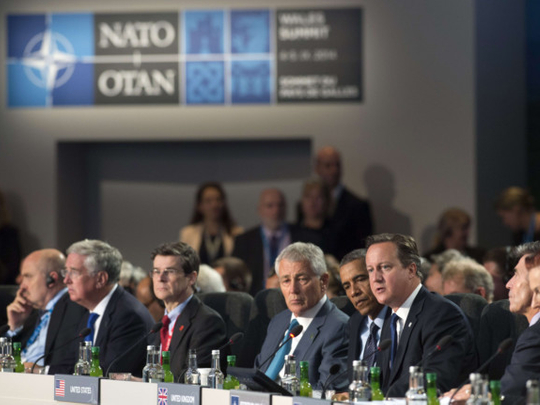
For the West’s masters of war, it is a good time to be in Wales. A military alliance that has struggled for years to explain why it still exists has got a packed agenda for its Newport summit. Nato may not be at the centre of US President Barack Obama and British Prime Minister David Cameron’s plans to ramp up intervention in the Middle East and wipe the so-called Islamic State of Iraq and the Levant (Isil) “out of existence”. But after 13 years of bloody occupation of Afghanistan and a calamitous intervention in Libya, the western alliance has got an enemy that at last seems to fit its bill. Swinging through the former Soviet republic of Estonia on Thursday, Obama declared that Nato was ready to defend Europe from “Russian aggression”.
Nato’s Secretary-General, Anders Fogh Rasmussen, who insisted as Danish prime minister in 2003 that “Iraq has weapons of mass destruction we know”, has released satellite images supposed to demonstrate Russia has invaded Ukraine. Not to be outdone, Cameron has compared Russian President Vladimir Putin to Adolf Hitler.
The summit is planning a rapid reaction force to be deployed across Eastern Europe to deter Moscow. Britain is sending troops to Ukraine for exercises. In Washington, Congress hawks are squealing appeasement and demanding action to give Ukraine “a more capable fighting force to resist” Russia.
Any hope that the talk of a ceasefire agreement by Ukraine’s president may signal an end to the conflict was sunk when his Prime Minister, Arseny Yatseniuk, an American favourite in Kiev, described Russia as a “terrorist state” and, encouraged by Rasmussen, demanded that Ukraine be allowed to join Nato.
It was precisely the threat that Ukraine would be drawn into a military alliance hostile to Russia, despite the opposition of most Ukrainians and its then elected government, that triggered this crisis in the first place.
Instead of keeping the peace, Nato has been the cause of escalating tension and war.
Which is how it has been since Nato was founded in 1949, at the height of the Cold War, six years before the Warsaw pact, supposedly as a defensive treaty against a Soviet threat.
It is often claimed the alliance maintained peace in Europe for 40 years, when in fact there is not the slightest evidence the Soviet Union ever intended to attack. After the Soviet Union collapsed, the Warsaw Pact was duly dissolved.
But Nato was not, despite having lost the ostensible reason for its existence. If peace had been the aim, it could have usefully been turned into a collective security arrangement, including Russia, under the auspices of the United Nations.
Instead, it gave itself a new “out of area” mandate to wage unilateral war, from Yugoslavia to Afghanistan and Libya, as the advance guard of a US-dominated new world order.
In Europe, it laid the ground for war in Ukraine by breaking a US pledge to Moscow and relentlessly expanding eastwards: First into ex-Warsaw Pact states, then into the former Soviet Union itself.
But the “biggest prize”, as raine’s corrupt but elected president, who refused to sign it, was overthrown in a US-backed coup by any other name — it was scarcely paranoid for Russia to see the takeover of the neighbouring state as a threat to its core interests.
Six months on, Moscow-backed eastern Ukrainian resistance to the Nato-backed nationalists in Kiev has become a full-scale war. Thousands have died and human rights abuses have multiplied on both sides, as government troops and their irregular auxiliaries bombard civilian areas and abduct, detain and torture suspected separatists on a mass scale.
The Ukrainian forces backed by western governments include groups such as the neo-Nazi Azov battalion, whose symbol is the wartime Nazi stormtroopers’ wolf’s hook.
The increasingly repressive Kiev regime is now attempting to ban the Ukrainian communist party, which won 13 per cent of the vote at the last parliamentary elections.
But then Nato, whose members have often included fascist governments in the past, has never been too fussy about democracy.
Evidence for its claims that Russian troops have invaded eastern Ukraine is also thin on the ground. Arms supplies and covert intervention in support of the Donbass rebels — including special forces and state-backed irregulars — are another matter.
But that is exactly what Nato powers such as the US, Britain and France have been busy doing all over the world for years — from Nicaragua to Syria and Somalia. The idea that Russia has invented a new form of “hybrid warfare” in Ukraine is bizarre.
That is not to say the proxy war between Nato and Russia in Ukraine is not ugly and dangerous.
But it is not necessary to have any sympathy for Putin’s oligarchic authoritarianism to recognise that Nato and the EU, not Russia, sparked this crisis and that it is the western powers that are resisting the negotiated settlement that is the only way out, for fear of appearing weak.
That settlement will have to include federal autonomy, equal rights for minorities and military neutrality as a minimum.
With the scale of bloodshed and the centre of political gravity in Kiev shifting to the right, as Ukraine’s economy implodes, only its western sponsors can make that stick. The alternative, after Crimea, is escalation and disintegration.
Nato likes to see itself as the international community. In reality it is an interventionist and expansionist military club of rich-world states and their satellites used to enforce western strategic and economic interests. As Ukraine shows, far from keeping the peace, Nato is a threat to it.
— Guardian News and Media Ltd









